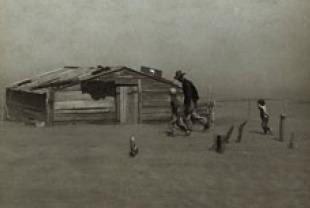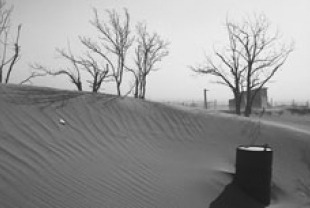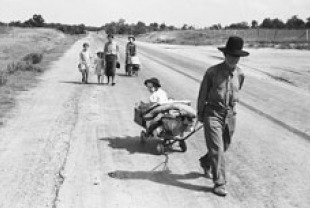Memory & Survivors
In his introduction to Hard Times: An Oral History of the Great Depression, Studs Terkel writes of the United States:
"Ours, the richest country in the world, may be the poorest in memory. Perhaps the remembrances of survivors of a time past may serve as a reminder to others."
History & Ordinary People
The same respect for history and the voices of ordinary people lies at the center of Ken Burns's The Dust Bowl airing on PBS on November 18 & November 19 from 8 - 10 pm ET each evening (check local listings for the times in your area). The film is then being released on PBS Blue-ray and DVD on November 20, 2012.
Living Through Hard Times
This stunning and edifying documentary was written by Dayton Duncan, is narrated by Peter Coyote, and features voiceovers by Carolyn McCormack, Patricia Clarkson, Kevin Conway, and Amy Madigan. Its history lessons are carried into our hearts and consciousness by rare movie footage, unpublished photographs, the ballads of Woody Guthrie, and the observations of a variety of men and women who lived through those hard times.
The Greatest Ecological Disaster in American History
Ken Burns calls the Dust Bowl — the terrible and prolonged drought which ravaged the Plains during the Great Depression — "the greatest man-made ecological disaster in American history." The film charts the environmental catastrophe which was brought on by the destruction of millions of acres of native grasslands to make room for wheat fields across the Plains. Farmers, who have to be gamblers given their reliance upon the weather and other uncontrollable factors, plowed the land day and night in the pursuit of big-time profits during the "wheat boom" years of good weather.
When the Depression hit and wheat prices fell, the government pleaded with farmers to cut back on production but, trying to make a profit at the lower prices, they actually plowed more land and harvested more wheat. A drought in the 1930s found millions of acres with no protective cover; the wind blew off the top soil creating huge dust storms thousands of feet high. Sometimes the storms covered several states; one carried dirt as far as New York and out into the Atlantic.
A Cautionary Tale about Progress & Profit
Burns wants to make it clear that "The Dust Bowl" is a cautionary tale that has great relevance to contemporary society where the same pursuit of progress and profit is fueling extreme climate change and an unprecedented series of environmental disasters. Burns has stated:
"The Dust Bowl was a heartbreaking tragedy in the enormous scale of human suffering it caused. But perhaps the biggest tragedy is that it was preventable. This was an ecosystem — a grassland — that had evolved over millions of years to adjust to the droughts, high winds and violent weather extremes so common to that part of the country. In the space of a few decades at the start of the twentieth century, that grassland was uprooted in the middle of a frenzied wheat boom. When a drought returned, all that exposed soil took to the skies, and people worried that the breadbasket of the nation would become the next Sahara desert. If we show the same neglect to the limits of nature now as we did then, it is entirely possible that this could happen again."
A Moving Wall of Dirt Blacker Than Night
Startling images of the terrifying dust storms are accompanied by the voices of 26 survivors who share their memories of what it was like to live through them. The "black blizzards" deposited mountains of dirt and blew through the cracks of doors into homes. They scattered debris everywhere.
People were often trapped in their homes for long periods of time. Meanwhile, cattle and other animals outside inhaled the dirt and suffocated. Trees, fences, and farm machinery were destroyed. Children developed "dust pneumonia" and died. Yet even in the face of this destruction and devastation, many farm families decided to stay firmly planted on their land.
The Dust Storms & the Depression & The Great Exodus
The extreme weather coupled with bankruptcies, foreclosures, and widespread unemployment drove many others to seek a new life out West. Despite all the suffering and loss these dust bowl refugees (given the name "Okies") had endured, they were not treated with kindness or compassion elsewhere. Instead they were harassed and attacked as job-stealing intruders. The plight of the Okies foreshadows America's present-day conflicts and enmity focused on immigrants.
Interesting Facts from Ken Burns's The Dust Bowl
• Farmers are "next year people" who habitually look forward with hope toward the next season.
• During the big wheat boom, suitcase farmers purchased small portions of land, planted wheat, and returned to reap the rewards at harvest time.
• So many coyotes were killed in the Plains states that the rabbit population exploded; during the drought hungry rabbits invaded the communities, eating everything green, including the gardens people relied upon. Drives were organized in which the rabbits were cornered and clubbed to death.
• The Dust Storm survivors speak positively about FDR's New Deal programs designed to create more jobs and to help the poor.
• Goggles and gas-masks were sold to help people navigate through the dust storms.
• Brown was the color of the world for survivors of the dust storms and in one community a woman refers to the vehicle dispensing food to the hungry as "the Brown Truck."
Special features on the 2-disc DVD set include an hour of bonus material not included in the TV version, including more eyewitness interviews and additional stories on the legacy of the Dust Bowl: "Land of Haze," "Dust Bowl Stories," "Uncovering the Dust Bowl," "Grab a Root and Growl," "The Dust Bowl Eyewitnesses," and "The Dust Bowl Legacy."


